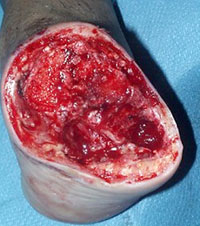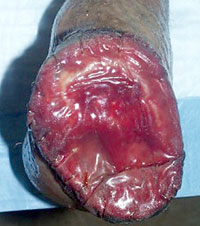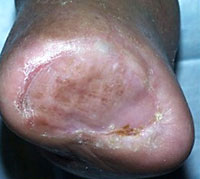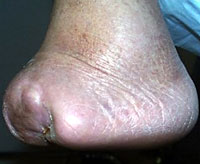
|
A 74-year-old man with diabetic
atherosclerosis developed forefoot ulceration leading
to necrosis and abscess. Transtarsal amputation
was done through cuboid and cuneiforms. This is
a competent amputation because all major tendons
to the ankle are still inserted, and the ankle is
motored and stable. However, osteotomies and intertarsal
joints are exposed and require cover.
|
 |
|
There is insufficient skin for
closure, but "creating" enough skin by
further bone recession will detach tendons and destabilize
the ankle warranting below knee amputation. There
are no local flaps, and arterial disease precludes
a free flap. Integra was used to manage this extremely
difficult wound.
|
 |
|
The wound healed without problems.
All care was managed as an outpatient. By using
a posterior "wedge shoe", the patient
remained ambulatory during latter parts of the reconstruction.
|
 |
|
This lateral view of the foot
demonstrates active dorsiflexion through the tibialis
anterior tendon, confirming that major tendons remain
inserted and active.
|
 |
|
Using an insert at the front
of a regular shoe, and a thin ankle-foot orthosis
for some additional stability, this patient has
led an otherwise normal life. Two years later,
he remains completely ambulatory and active. Integra
has been consistently successful in closing midfoot
amputations. There should no longer be any need
to throw away an extremity only for the want of
a good flap. Integra should be the preferred option
for salvaging complex foot wounds in high-risk
patients.
|
 |
Cases Courtesy of:
Marc E. Gottlieb, M.D., Jennifer Furman
Journal of Burns and Wounds, Vol 3, #2